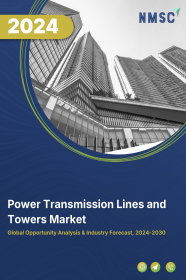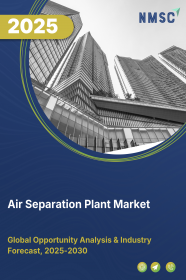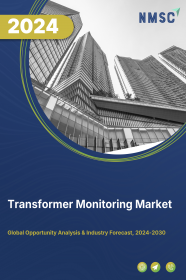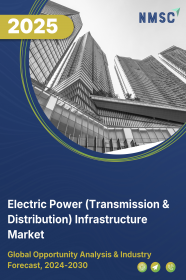
Power Transmission Lines and Towers Market by Type (Overhead, Underground, and Submarine), by Product (Transmission Lines and Transmission Towers), by Conductor (Conventional and High Temperature), by Insulation (PVC and XLPE), by Voltage (132 kV to 220 kV, 221 kV to 660 kV, and more than 660 kV), by Current (HVAC and HVDC), and by Application (High Tension, Extra-High Tension, and Ultra-High Tension) - Global Opportunity Analysis and Industry Forecast 2024-2030
Power Transmission Lines and Towers Market Report - Comprehensive Overview | |
| Study Period | 2020 - 2030 |
| Base Year for Estimation | 2024 |
| Forecast Data Period | 2026 - 2030 |
| Market Size in Base Year | 46.22 |
| Market Size in Forecast Year | 58.11 |
| Growth Rate 2026 - 2030 | 4.68% |
| Growth Factors | |
| Report Coverage | The report provides insights on market size, forecasts, emerging trends, competitive landscape, key segments, growth opportunities, recent developments, and strategic recommendations to help stakeholders make informed business decisions. |
| Segments Covered | Power Transmission Lines and Towers Market by Type (Overhead, Underground, and Submarine), by Product (Transmission Lines and Transmission Towers), by Conductor (Conventional and High Temperature), by Insulation (PVC and XLPE), by Voltage (132 kV to 220 kV, 221 kV to 660 kV, and more than 660 kV), by Current (HVAC and HVDC), and by Application (High Tension, Extra-High Tension, and Ultra-High Tension) |
| Countries Covered | 28 |
| Geographical Analysis | North America (The U.S., Canada, Mexico); Europe (The UK, Germany, France, Italy, Spain, Denmark, Netherlands, Finland, Sweden, Norway, Russia, Rest of Europe); Asia-Pacific (China, Japan, India, South Korea, Australia, Indonesia, Singapore, Taiwan, Thailand, Rest of Asia-Pacific) and RoW (Latin America, Middle East, Africa) |
| Companies Profiled | Top 10 companies |
| Competitive Landscape | |
| Market Share | Available for top 10 companies |
| Customization Scope | Free customization (equivalent to up to 80 working hours of analysts) after purchase. Addition or alteration to country, regional, and segment scope. |
| Purchase Option | Avail customized purchase options to meet your exact research needs. |
Market Definition
The Power Transmission Lines and Towers Market size was valued at USD 41.46 billion in 2023 and is predicted to reach USD 58.11 billion by 2030 with a CAGR of 4.9% from 2024-2030. Power transmission lines and towers are the infrastructures used to transport electricity from the electrical power grid to consumers. The electricity is transported between the towers with high voltage electricity running through the transmission lines. These lines can be either overhead or underground. Underground transmission lines are buried beneath the earth, whereas overhead transmission lines are supported by towers or poles. The lines are made of copper and aluminum to carry high-voltage electrical current over long distances.
The towers are made from steel, wood, or concrete and are designed to support the weight of the wires and insulators that carry the electricity. The towers are carefully placed along the transmission lines to minimize the risk of power outages and away from trees and other obstructions. The main benefit of power transmission lines and towers is that it allows electricity to be delivered from the place it is generated to the places it is needed. This helps to reduce the cost of electricity by transmitting energy more efficiently. This is essential for modern society, as it allows us to use electricity to power our homes, workplaces, and public services.
Market Dynamics and Trends
The demand for power transmission lines and towers is significantly boosted by the increasing need for electricity across residential, commercial, and industrial sectors worldwide. According to the latest report published by the International Energy Agency, global electricity demand is growing at a significant rate, with an increase of 3.4% in 2024 as compared to 2023.
This rise in electricity demand is boosting the need for expanding and upgrading power transmission infrastructure to ensure reliable and efficient distribution of electricity to meet the needs of various sectors. Moreover, the increasing government initiatives and investments to promote the use of renewable energy sources such as solar and wind power to meet electricity demand are driving the growth of the market.
For instance, projects such as the Tengger Desert Solar Park in China, the Ivanpah Solar Facility in the U.S., and the Dogger Bank Wind Farm in the UK, are driving the demand for extensive power transmission infrastructure, including transmission lines and towers to distribute the generated electricity efficiently across regions.
However, the high installation and regular weather-related damage maintenance costs are the major factors restraining the growth of the market. On the contrary, the introduction of fiber-reinforced polymer (FRP) composites in transmission lines is expected to create significant opportunities for the market in the coming years. FRP composites offer several advantages, including high durability, stiffness, damping properties, flexural strength, and resistance to corrosion, wear, impact, and fire. enhancing the reliability and longevity of power transmission infrastructure in challenging environmental conditions while reducing the maintenance cost.
Market Segmentations and Scope of the Study
The power transmission lines and towers market share is segmented on the basis of type, product, conductor, insulation, voltage, current, application, and region. On the basis of type, the market is divided into overhead, underground, and submarine. On the basis of product, the market is classified into transmission line and transmission tower. On the basis of conductor, the market is segmented into conventional and high temperature. On the basis of insulation, the market is divided into PVC and XLPE. On the basis of voltage, the market is divided into 132 kV to 220 kV, 221 kV to 660 kV, and more than 660 kV. On the basis of current, the market is classified into HVAC and HVDC. On the basis of application, the market is divided into high tension, extra-high tension, and ultra-high tension. Regional breakdown and analysis of each of the aforesaid segments include regions comprising of North America, Europe, Asia-Pacific, and RoW.
Geographical Analysis
Asia Pacific holds the dominant share of the power transmission lines and towers market and is expected to continue its dominance during the forecast period. This is attributed to factors such as the rising population and growing industrialization in countries such as China and Japan. According to World Energy & Climate Statistics, China is the largest electricity consumer with 31% of global electricity consumption in 2021.
Moreover, the growing government investment in building new transmission of electricity and replacing conventional grids with clean energy is further driving the growth of power transmission lines and towers market. For instance, the government of India planned to invest USD 29.6 billion to build transmission lines by replacing grids to clean energy and increase its inter-regional transmission capacity from 112 gigawatts to 150 gigawatts by the end of 2030.
On the other hand, North America is expected to show a steady rise in the power transmission lines and towers market due to rise in the use of renewable energy sources like wind and solar power has been a major driver for the growth of the power transmission lines and towers market in this region.
According to the budget for 2022 released by the government of Canada, Canadian government expanded its investment in Smart Renewables and Electrification Pathways (SREPs) program USD 440 million to support renewable electricity and grid modernization projects.
Moreover, the growing demand for electricity in this region and the need for better power transmission infrastructure is further driving the growth of the market in this region. According to United States Energy Information Administration, the demand for electricity in U.S. increased by 2.7% in 2022 due to growing economic activities.
Competitive Landscape
Various market players operating in the power transmission lines and towers market include Nexans S.A., Ltd., ABB Ltd., General Electric Company, Prysmian Group, Sumitomo Electric Industries, Ltd., Valard Construction LP, Arteche Group, MYR Group Inc., Kiewit Corporation, Burns & McDonnell, Aecom, Mytilineos Holdings S.A., Tokyo Electric Power Company Holdings, Inc., SAE Towers, LLC., Schneider Electric SE, and others. These market players are adopting various strategies such as new contracts with foreign governments, collaborations, and new project developments to remain dominant in the market.
For instance, in December 2022, General Electric and MYTILINEOS entered into a contract with the Electricity Supply Board of Ireland (ESB) for the construction of a new gas-fired power plant and approximately 200 megawatts to help meet the electricity demand and help ensure the stability of electricity supply in Ireland.
Also, in October 2022, Fujitsu collaborated with Chugoku Electric Power Transmission & Distribution Co. Inc. to use environmental data such as wind conditions, and transmission line temperatures, and to use drones for improving the maintenance of power transmission facilities.
Moreover, in June 2021, Prysmian Group was provided with USD 900 million for building a clean energy grid in the U.S. under project SOO Green HVDC Link 2,100-megawatt interregional project. The project is aimed to link two of the largest energy markets in the US to reliably and efficiently transmit enough renewable energy to power more than 1.2 million homes.
Key Benefits
-
The report provides quantitative analysis and estimations of the power transmission lines and towers market from 2024 to 2030, which assists in identifying the prevailing market opportunities.
-
The study comprises a deep-dive analysis of power transmission lines and towers market including the current and future trends to depict prevalent investment pockets in the market.
-
Information related to key drivers, restraints, and opportunities and their impact on the power transmission lines and towers market is provided in the report.
-
Competitive analysis of the players, along with their market share is provided in the report.
-
SWOT analysis and Porters Five Forces model is elaborated in the study.
-
Value chain analysis in the market study provides a clear picture of roles of stakeholders.
Key Market Segments
By Type
-
Overhead
-
Underground
-
Submarine
By Product
-
Transmission Lines
-
Transmission Towers
By Conductor
-
Conventional
-
High Temperature
By Insulation
-
PVC
-
XLPE
By Voltage
-
132 kV to 220 kV
-
221 kV to 660 kV
-
More than 660 kV
By Current
-
HVAC
-
HVDC
By Application
-
High Tension
-
Extra High Tension
-
Ultra-High Tension
By Region
-
North America
-
The U.S.
-
Canada
-
Mexico
-
-
Europe
-
The U.K.
-
Germany
-
France
-
Italy
-
Spain
-
Denmark
-
Netherlands
-
Finland
-
Sweden
-
Norway
-
Russia
-
Rest of Europe
-
-
Asia-Pacific
-
China
-
Japan
-
India
-
South Korea
-
Australia
-
Indonesia
-
Singapore
-
Taiwan
-
Thailand
-
Rest of Asia-Pacific
-
-
Rest of the World (RoW)
-
Latin America
-
Middle East
-
Africa
-
REPORT SCOPE AND SEGMENTATION:
|
Parameters |
Details |
|
Market Size in 2023 |
USD 41.46 Billion |
|
Revenue Forecast in 2030 |
USD 58.11 Billion |
|
Growth Rate |
CAGR of 4.9% 2024 to 2030 |
|
Analysis Period |
2023–2030 |
|
Base Year Considered |
2023 |
|
Forecast Period |
2024–2030 |
|
Market Size Estimation |
Billion (USD) |
|
Growth Factors |
|
|
Countries Covered |
28 |
|
Companies Profiled |
15 |
|
Market Share |
Available for 10 companies |
|
Customization Scope |
Free customization (equivalent to up to 80 working hours of analysts) after purchase. Addition or alteration to country, regional, and segment scope. |
|
Pricing and Purchase Options |
Avail customized purchase options to meet your exact research needs. |
KEY PLAYERS
-
Nexans S.A. Ltd.
-
ABB Ltd.
-
General Electric Company
-
Prysmian Group
-
Sumitomo Electric Industries Ltd.
-
Valard Construction LP
-
Arteche Group
-
MYR Group Inc.
-
Kiewit Corporation
-
Burns & McDonnell
-
Aecom
-
Mytilineos Holdings S.A.
-
Tokyo Electric Power Company Holdings Inc.
-
SAE Towers LLC
-
Schneider Electric SE




















 Speak to Our Analyst
Speak to Our Analyst





















